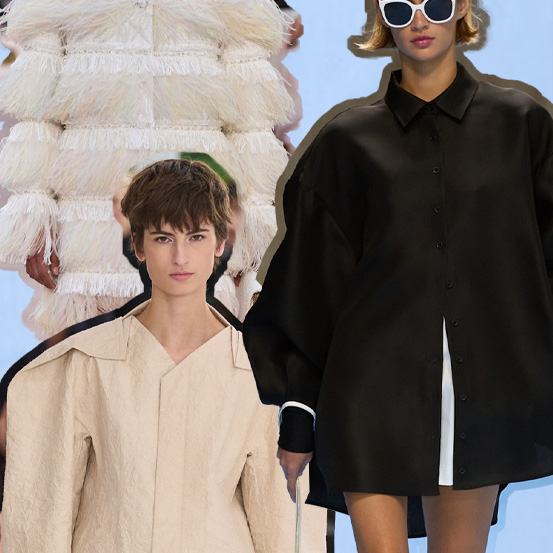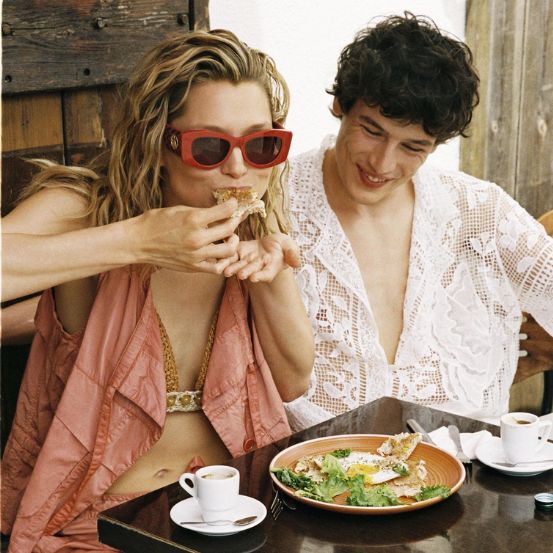The Icons Issue
Hairlines: a silhouette, a cut, and a look that is recognized miles away.
As the popular phrase would go, these days, the word 'iconic' is thrown around far too easily. The term 'iconic' was once reserved for describing something or someone with a lasting, almost sacred influence.. Over time, especially in modern media and pop culture, the term started being applied to anything from celebrities to fashion trends,which in turn has led to the criticism that it's used too casually or frequently, losing its original gravitas. But in hair, what makes for an iconic hairstyle?
Could it be that one can recognize it just by looking at a specific silhouette or shadow—like a certain ponytail or blunt-cut bob, or the fact that it’s used as a noun when asking for a new cut or hairstyling? Does it become iconic when it’s christened and known by the general public, from the local fashion girl to the middle-aged mom-of-three? To better understand the implications of the word 'icon' and what truly makes a look iconic, Vogue Portugal sat down with the world-renowned and founder of his eponymous haircare and styling brand Kevin Murphy to dissect the look and pin down the nuances of hair that has gained icon-status.
“I would say yes, the test of time is what’s really important, a hairstyle that you would consider iconic is something that looks like you were born with it,” starts Murphy. “Now, this doesn’t mean that the hairstyle stays the same, as it will naturally change and evolve over time with the person. Dianna Vreeland said, ‘get a look and stick to it.’ A truly iconic hairstyle transcends trends and taps into something timeless, whether it's through a revolutionary shape, texture, or cultural moment that aligns with it. It’s something that feels fresh, yet classic.” Like Rome, an iconic hairstyle isn’t built in a day.
Now, throughout history, we’ve seen certain hairstyles become synonymous with influential figures. Yet, how much is ‘hair’, and how much is ‘person’ when it comes to identity-building and icon-status achievement? “I think that throughout history we have seen a person’s hairstyle as a signal where they might have sat in society—like how some cultural groups use hairstyles to symbolize who they are,” details Murphy. “Hairstyles can also indicate social or marital status, religion, and other core areas of identity— like Audrey Hepburn’s streaky updo in Breakfast at Tiffany’s or David Bowie’s bold mullet. Each look has become iconic because they reflect the personality and essence of the person wearing them. It’s not just about the style itself, but about how that person, and the moment, challenges the norms,” he continues. “Their hair becomes a symbol of something larger than just beauty. Hairstyling was not the norm for everybody and people didn't change their hair as much as a person would do now. Take for example certain celebrities like Madonna, who seems to change her hair every five minutes, this was not the case in the past.”
From there, the conversation naturally veers into how cultural moments and societal shifts influence the rise—or downfall—of iconic hairstyles. How their mere existence plays a key role in establishing what will be considered iconic for decades to come. “ Take the bob of the 1920s, for example—it symbolized the liberation of women at a time when society was changing. Hair becomes a reflection of freedom, rebellion, or conformity, depending on the times. When the world shifts, so do the styles,” illustrates Murphy.
To move forward with dissecting their phenomenon, we must now look at some of the most iconic hairstyles from the past decades. “Farah Fawcett Majors was probably the one that springs to mind first when thinking of iconic hair, as she was really part of my youth and everybody talked about her hair all the time. There were rumors going around when I was a teenager that she cut her own hair into that style,” reminisces Murphy. “Twiggy was one of the first girls to really popularize short hair and Edie Sedgewick was also one of the more famous Warhol muses with her unique style. Later, there was Debbie Harry of Blondie who popularized the bleached hair at the front and dark hair at the back, which made it look like she had done it herself and couldn't reach the back, but I'm sure it was crafted for her.”
This last comment raises the pivotal question: can icons be crafted on demand? Which turns out, it’s not so much what is crafted, rather than how it’s crafted, as what is iconic should be unique, and for that, it should be custom made. “It's really important when creating that you keep a person’s personality in mind. In the salon we would always look at someone's shoes as it gave you a clue to how you might finish off the style depending on their shoe choices and a lot of the time it's all that popped out of the cutting cape,” explain Murphy in full seriousness, “shoes are a dead give way into someone's personal style and at the end it’s always about tapping into the individual’s essence. It’s about understanding their personality, their energy, and where they’re heading, especially if they’re in the public eye. A personal yet impactful style reflects not only the individual but the story they want to tell.”
With this said, and timelessness being established as a key aspect itself of an iconic hairstyle, not even the concept of 'iconic' has remained intact over the years, evolving alongside the styles deemed worthy. Similarly to how the rigid structures of the past, like the bouffant of the 1960s, have evolved to the more fluid and natural styles we see today. “People now celebrate authenticity, individuality, and effortless beauty. We’re seeing more inclusivity, with natural textures and diverse styles taking center stage,” reflects Murphy. “Now we change our looks so much that it's hard to keep up, new advances in science have given us the opportunity to change our hair often and Gen Z’ers are obsessed with hair color and reinvention. In the past you could not change your style as much or as successfully as we can today so you kind of stuck to a look or risked your hair falling off.”
In turn, this plays alongside the lines of self-expression and personal image—which naturally affects how styles deemed iconic reflect in modern-day society. “Today the idea of a hairstyle is achievable for everyone, and hair is often a powerful signal of personality. You can use a haircut, hair color, or texture to show who you are to the world,” explains Murphy, “I feel that self expression breaks down the norms and hair is a really big part of our self expression. When someone like Grace Jones wore her flat top, she defied expectations of femininity. These styles often push back against traditional notions, creating space for new expressions of identity,” he continues, framing how today’s society defines what is iconic and what it takes to make the cut.
For Murphy, the key to an iconic hairstyle lies not just in its technical brilliance but in the person who wears it. A bit of a nod to the popular phrase, ‘fashion can be bought, style one must possess’. Throughout time and history, certain figures have transcended beauty standards, their hairstyles becoming synonymous with their identities—Audrey Hepburn’s timeless updo, Grace Jones’ daring flat-top, and Farrah Fawcett’s feathered waves that came to define an era of carefree beauty. “A great haircut empowers the wearer,” Murphy reflects. “It’s not just about the style itself but about how the person carries it—how they embody it.”
Looking back at his own career, Murphy has been at the helm of some truly iconic looks—styles that have become defining markers of entire eras. The beehive, for instance, a structured ode to ‘60s glamor, has evolved into something looser, yet no less impactful. His creation of beach waves in the ‘90s was a reaction against the rigid ‘piss elegance’ of the ‘80s, birthing a movement of effortless chic that flowed from sun-drenched Australian shores to red-carpet runways and countless magazine editorials. “These styles endure because they adapt, but they never lose their soul,” he explains. Each evolution is a testament to the power of reinvention—because while trends come and go, their roots remain deep.
Murphy emphasizes that what makes a hairstyle iconic is the same thing that makes a person iconic—authenticity. “It’s about tapping into who they really are and creating something that feels unique to them but timeless in its appeal,” he says. It’s a careful balancing act—between classicism and innovation, the past and the future—much like how iconic figures themselves walk the line between societal expectations and personal reinvention. Their hair becomes a symbol, a statement of who they are and the cultural moment they occupy.
As trends come and go, the hairstyles that endure are those that tell a story—whether a reflection of rebellion, a signal of societal change, or a defiant stand against what is considered the norm. From the daring bob of the 1920s that symbolized women’s liberation to the shaggy mullet, which has now become the face of modern self-expression, these looks aren’t just about aesthetics—they mirror the people and the times that defined them.
As we look toward the future of beauty, Murphy’s insights remind us that the icons of today—and their distinctive hairstyles—are already shaping the landscape of tomorrow. In this fluid and ever-evolving world, hair transcends mere aesthetics; it becomes a powerful declaration of identity and a reflection of cultural narratives. Each hairstyle tells a story, whether it symbolizes rebellion, celebrates individuality, or signifies a shift in societal norms.
In a realm often defined by fleeting trends, true style endures, carving its place in history not solely by its appearance, but by the lives it touches and the emotions it evokes. As Murphy aptly states, “Hair can be a tool, but it’s the people who wear these styles that make them unforgettable.” This essence of what makes a hairstyle iconic lies in its ability to resonate deeply with those who wear it, anchoring them in authenticity while allowing for personal expression. This is how we become iconic—not through mere imitation, but by embracing our unique narratives and sharing them with the world.
Translated from the original in Vogue Portugal's The Icons Issue, published November 2024. Full story and credits in the print issue.
Relacionados

.png)
Da MAC para o Mundo: tudo o que importa saber sobre as tendências de maquilhagem atuais
09 Apr 2025
.jpg)
.jpg)





.jpg)